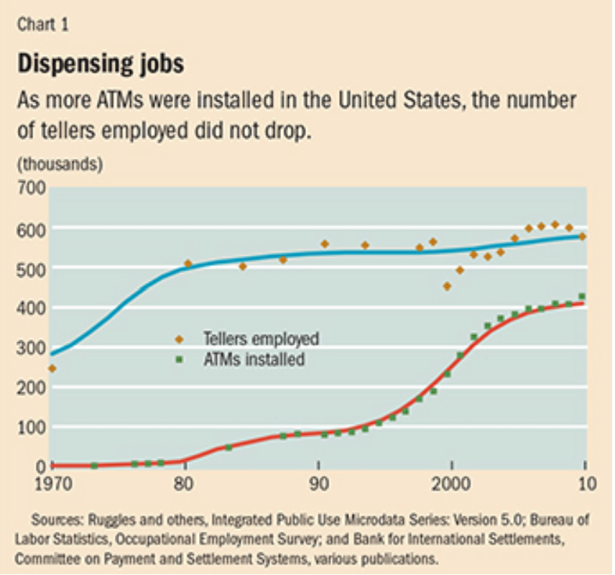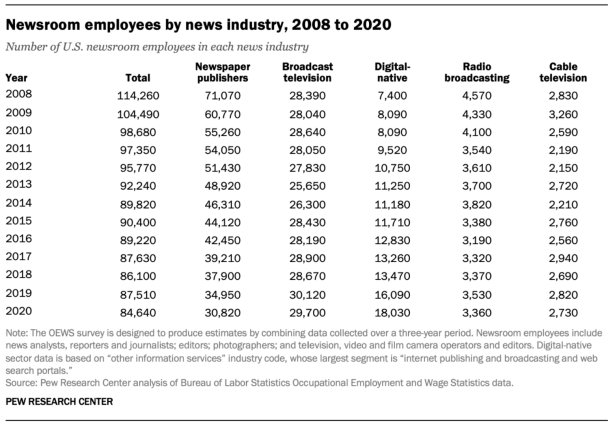The Idea In 60 Seconds
- It’s natural to be concerned over job losses resulting from the introduction of AI.
- I’m so concerned, I’m reading and blogging about it.
- However, there are many examples from recent history in which new technology raises employment overall.
- Looms meant more textile workers, ATMs led to more bank cashiers and eCommerce reduced retail employment but raised warehouse worker numbers.
- Underneath the winners and losers across these industries is an economic concept called price elasticity of demand.
Are We All About To Lose Our Jobs?
Anyone paying attention will be concerned for their jobs. There are astounding AI news stories every day, many of which point to the potential productivity and unemployment implications of the rapidly evolving technology. Considering the history of automation, however, when it comes to the unemployment we might be looking at on the horizon, things might not be all that bad.

What Happened To Book-Keepers When Microsoft Launched ‘Excel’ – Net Positive
Microsoft launched their spreadsheet, Excel in 1987. Morgan Stanley famously did some research using US Labor Department statistics. Here’s what they found happened to the numbers.
- Bookkeepers and accounting clerks fell from 2 million to 1.5 million
- Accountants and auditors rose from 1.3 million to 1.5 million,
- Management analysts and financial managers increased from 600,000 to 1.5 million.
The implication is that some jobs were lost but overall, more were created and people ‘upskilled’ from mental grunt work to positions which added more value, were probably more interesting an earned them more money.

What Happened To Bank Tellers When The ATM Was Introduced ? – Net Positive
When banks put ATMs in place 25 years ago, a similar thing happened. The number of full-time equivalent teller jobs actually grew.

IMP Data shows that when ATMs were introduced, more bank tellers were hired.
ATMs enabled banks to reduce the operating costs of branches, leading to a proliferation of branches and, by extension, a maintained or increased demand for bank tellers.
What Happened In Manufacturing When Machines Replaced Humans? Net Positive
Historical data from the 19th century shows a similar thing. The automation of weaving reduced the labor required by 98% but the number of weaving jobs increased. Lower prices for textiles led to a surge in demand. Because individual textile workers could now man multiple machines, their wages went up, too.
Desktop Publishing / Graphic Design – Net Positive
Desktop publishing software released in the 1990s revolutionized graphic design, transitioning from analog to digital processes. While this led to a projected 13% decline in employment for desktop publishing specialists between 2010 and 2020, the Bureau of Labor Statistics anticipated a 27% growth in employment for web developers and digital designers during the same timeframe.
Ecommerce vs Retail – Net Negative
In the retail sector, the shift towards online shopping actually did lead to a decline in brick-and-mortar store employment, but according to the Progressive Policy Institute, it created more jobs in e-commerce and related fields. The new jobs paid more and contributed to a reduction in Income Inequality.
Journalism – Net Negative
Things haven’t been so good for Journalists. According to the Pew Research Center,

Journalists are one category where technological change negatively affected their industry. Of course, other factors, including the introduction of online advertising as a way of paying for news had an effect.
What Determines Whether There is a Net Growth Or a Net Decline In Employment?
Price elasticity of demand is a key factor in determining how an industry will fare when confronted with AI automation.
Price elasticity of demand measures how sensitive the quantity demanded of a good or service is to a change in its price. When demand is inelastic, consumers’ purchasing behavior does not change much with price fluctuations. Cigarettes are a good example of Inelastic Demand. When you raise the price of ciggies, people still buy the same amount because they’re addicted.
Conversely, when demand is elastic, consumers buy significantly more of a good or service when its price decreases. For example, textiles in the example above. When they got cheaper, people bought a lot more. Similarly ATMs. When it became cheaper for the banks to open more branches because the grunt work was done by a machine, banks opened more branches and demand for tellers rose.
We Need To Keep Learning And Policy Needs To Prioritise Industries More Affected Because Of Low Price Elasticity Of Demand
The ‘problem’ of Automation causing net job losses comes up again and again. Leading economists during the Great Depression spoke then of these same phenomena, pointing out that Automation is
“lowering the cost of production to make a price within reach of large masses of purchasers.” source
–– while acknowledging the difficulty at the level of a displaced individual. At the time, productivity improvements from the mechanization of industry were running at about 3% – roughly twice the rate that even the most optimistic estimates of what AI will generate.
In a sense, we know all this intuitively. We all know that everyone used to work in agriculture and now combine harvesters do that but we all still have jobs. We all know that after the Industrial Revolution, machines replaced humans in factories but now we all still have jobs and those jobs pay more and are less dangerous.
Seeing the numbers and history of technology adoption, overall, perhaps we shouldn’t be surprised that there appears to be a net loss in traditional roles but a substantial gain in new, often more technologically advanced positions with higher wages, when automation solutions (like AI) is put in place. Often, the work is more enjoyable, too.
As individuals, we need to consider the importance of adaptability and lifelong learning, being ready to retrain to stay relevant. If we do, we might earn more.
It seems governments need to understand the elasticity of demand in various sectors and to craft educational and training programs that ensure workers are equipped for the jobs created by the changing demands of a technology-driven economy. I’m sure they’re on it.
